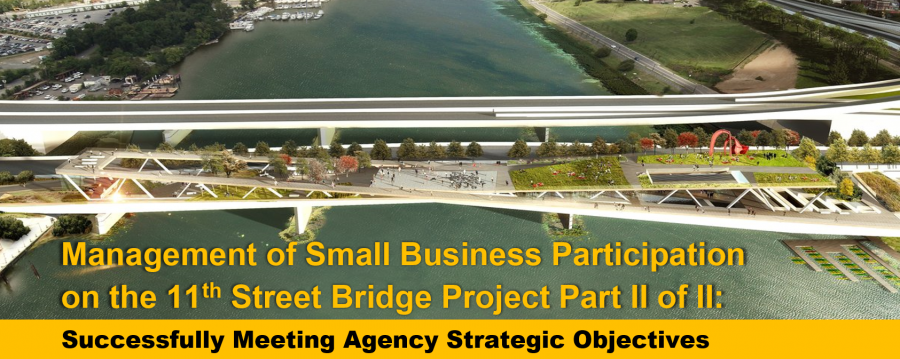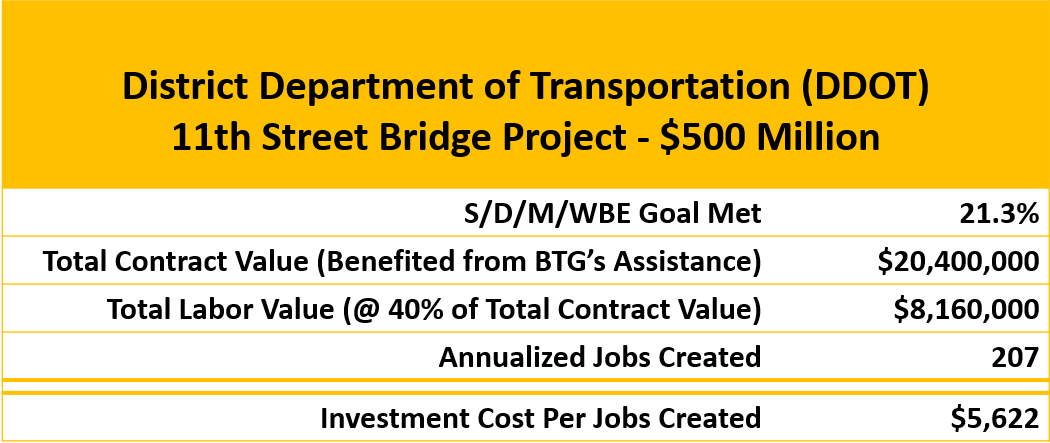Management of Small Business Participation on the 11th Street Bridge Project Part II of II: Successfully Meeting Agency Strategic Objectives
08/20/2020 | BTGINTRODUCTION
By far the largest District Department of Transportation (DDOT) project completed to date, the 11th Street Bridge Project in Washington, DC was critical to improving travel and achieving the larger vision of the Anacostia Waterfront Initiative (AWI). The two-phased project replaced two bridges built in the 1960s with three bridges that separated local and freeway traffic. The freeway bridges also provide connections between 1-695 (also known as the Southeast-Southwest Freeway) and DC-295, a 14-foot-wide pedestrian and bicycle sidewalk on the local bridge that connects to the Anacostia Riverwalk Trail, drainage and other environmental investments to treat all storm water within the project area, an additional evacuation route, and design accommodations for the future streetcar system.
See Management of Small Business Participation on the 11th Street Bridge Project Part I: Design-Build Approach and OCR Compliance here.
Part II
The DBE Steering Committee (DDOT, OCR, FHWA, PMT, and SFJV) was established to maintain key stakeholder involvement with the purpose of prioritizing the project objectives and outcomes, managing budget to ensure the project met financial and construction targets, developing risk management strategies that addressed threats to the project’s success, and implementing project management and quality assurance practices.
Opportunity sessions helped the DBE and CBE businesses align the scope of their offerings with the project’s requirements. The knowledge gained also helped the businesses understand how to get involved in early bid estimations that occur months before construction begins and when the prime contractors are developing their financial models for the project.
Compliance requirements were necessary but not difficult and tedious. BTG’s Online OCS™ was used to help support PMT’s management solution. It provided automated tracking that maintained compliance with the U.S. Department of Transportation’s regulation (49 CFR Part 26) for the large-scale design-build project. OCS™ collected and organized subcontractor data at multiple tiers while also presenting an enterprise view of project or program goals. Easy access was provided to DDOT staff for approving payments and a streamlined report was made available to all interested stakeholders.
This multi-year project accomplished several milestones. These accomplishments, identified in the box labeled 11th Street Bridge Project Accomplishments (PART II), were possible due to the project management approach and strategy that was implemented to help qualified small businesses win contracts and gain an understanding of the design-build procurement process. The strategic partnerships who were created for this design-build project assisted over 350 small businesses win contracts worth approximately $20.4 million. These partnerships also helped drive new jobs and revenue in the local economy. More than 200 jobs were produced with an investment of less than 1% of the overall project cost.
USING A PROJECT MANAGEMENT APPROACH TO REACH THE SMALL BUSINESS GOALS
DDOT and BTG worked together to establish an approach and project plan to manage the $20M DBE. This approach is like a traditional project management office (PMO) approach that most organizations take when delivering on a complex, multi-million-dollar project. DDOT and BTG established a team organization, processes, and strategies to increase the likelihood of success. Since the 11th Street Bridge was such a massive construction project, a goal management structure was also created.
The goal management structure helped encourage collaborative planning and functional groups to deal with daily operations and compliance. This team included members of executive management and a functional Work Group. The DBE Steering Committee included key stakeholders that met monthly to discuss decisions regarding issues escalated by the Work Group. Roles on the Executive Management Team included DDOT’s Chief Engineer, the DDOT Program Manager, the DDOT OCR Chief, and the prime contractor’s Project Director. The Chief Engineer was designated as the point of responsibility for the goal and was also responsible for managing expectations of the corporate and political leaders who were in support of the project. Supporters included the Mayor, the project area city council person, and DDOT Director.
In summary, prior to the 11th Street Bridge project starting, there was a question of whether there were enough qualified DBE and CBE companies available to perform on a project of this magnitude. The project has shown what can be accomplished to answer that question. An increased number of small businesses on a hundred-million-dollar design-build project is achievable, if the project is managed properly and cost are justifiable. The chart below shows the results of DDOT’s investment in assisting the prime contractor with additional business and technical expertise. It produced over 200 jobs and costed less than $6,000 per job produced – a relatively small fraction of the overall project cost.
Majority of the DBE and CBE contractors successfully met their budget and timeline requirements on the project. The PMO approach gained millions of dollars for small businesses on this large design-build project, while managing risks and maintaining quality. To be most successful, it is important that this small business utilization approach be part of the negotiation and planning discussions for large scale design-build procurement. It is also important to vet and assess the DBE’s and CBE’s strengths, weaknesses, capabilities, and capacity as part of the process to manage the overall project risk.
About DDOT: The District Department of Transportation (DDOT) is committed to achieving an exceptional quality of life in the nation’s capital through more sustainable travel practices, safer streets and outstanding access to goods and services. Central to this vision is improving energy efficiency and modern mobility by providing next generation alternatives to single occupancy driving in the city.
About BTG: At BTG, we provide turnkey solutions that minimize risk and optimize the inclusion of small businesses on large, complex projects. Headquartered in Washington D.C., our management consulting firm is established as the preferred partner to lead inclusion programs for multi-billion-dollar construction projects and P3 initiatives. We work with public and private sector clients of all sizes to ensure that compliance requirements are met and apply exclusive technology tools and methodologies to cultivate the use of small businesses, so all operate at peak performance. To learn more about BTG, please visit www.btgworks.com.

